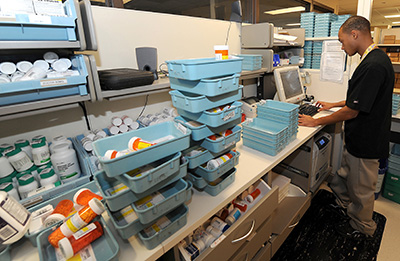Cold chain pharma logistics is heating up
This consumer-focused “cold chain”—temperature controlled supply chain—is only a recent example of a decades-long push to perfect a global system of item level tracking in supply chain management.
Most of us have seen the ads, while millions are ordering fresh food delivered as ready-to-prepare ingredients to their homes—products that require control of exposure to extreme temperatures and extended last-mile transit times.
This consumer-focused “cold chain”—temperature controlled supply chain—is only a recent example of a decades-long push to perfect a global system of item-level tracking in supply chain management. While the food industry has been dealing with this issue for hundreds of years, the pharmaceutical (pharma) industry is, by comparison, just getting warmed up.
Two major factors are driving the change in the pharma supply chain. First is the critical need to eliminate counterfeit drugs. The World Health Organization (WHO) is estimating that 10% of the drugs that reach consumers are fake—that is to say “useless” or even containing harmful substitutes. To solve this challenge, the industry is adopting technology to maintain a “pedigree,” or a chain of ownership from manufacturing through retail distribution.
The second factor is the increasing variety of drugs that require temperature control while in transit. “The storage and distribution of controlled room temperature [CRT] life science products are a costly and complex process, and requires attention at every level from packaging to logistics and monitoring to data,” Lisa Forian, senior director of product quality management at Johnson & Johnson recently wrote. “As we enter an age of biologically based medicines, the need to monitor and control temperature sensitivity is increasing.”
To summarize Forian’s comments, reaching patients in remote areas, perhaps by drone, with a prescription that is 2 degrees to 8 degrees centigrade is a challenge worthy of our best supply chain engineers.
Indeed, the temperature challenge is more difficult for pharma shippers, and requires both a monitoring tool and a symphony of coordinated actions all along the supply chain. The solution for shippers and service providers in both areas is LCP—learn, collaborate and pilot.
Under “learn,” I recommend becoming familiar with international efforts in safe pharma logistics. The WHO has issued good distribution practices (GDP) for pharmaceutical products standards, and I would consider becoming a temperature assurance packaging (TAP) professional through courses offered by industry professionals.
Mastery of the subject means one can understand the fundamentals of temperature assurance packaging and be able to evaluate different solutions that best meet the needs of their company; guide the implementation of temperature assurance packaging solutions within your organization; and grasp the key processes, protocols and techniques involved in designing temperature-controlled packaging.
Under “collaborate,” shippers need to be become even more transparent with their partners and work jointly to model and build end-to-end supply chains with tracking. In fact, I recently had the honor of leading a joint industry team of shippers, third-party logistics providers and carriers in testing tracking capabilities using RFID hardware combined with tracking software shared by the participants.
This was one of several labs developed to successfully demonstrate pedigree logistics feasibility to the U.S. Food and Drug Administration. The parties openly shared internal processes and technologies in order to achieve remarkable visibility to possession and handling of the product.
“Pilot” is the step where the parties actually move products through the supply chain, monitoring each step and critically evaluating their own and their partners’ performance. When you boil it all down, digital communication and data collection are the true enablers for cold chain.
While technologies are becoming available, the processes and people skills needed are still in development. Shippers and carriers in the cold chain stream need to step up and learn, collaborate and pilot for safe, efficient service to customers. •
“When you boil it all down, digital communication and data collection are the true enablers for cold chain.

Article Topics
Motor Freight News & Resources
LM Podcast Series: Assessing the freight transportation and logistics markets with Tom Nightingale, AFS Logistics XPO opens up three new services acquired through auction of Yellow’s properties and assets FTR’s Trucking Conditions Index weakens, due to fuel price gains TD Cowen/AFS Freight presents mixed readings for parcel, LTL, and truckload revenues and rates Preliminary March North America Class 8 net orders see declines National diesel average heads down for first time in three weeks, reports EIA Trucking industry balks at new Biden administration rule on electric trucks: ‘Entirely unachievable’ More Motor FreightLatest in Logistics
LM Podcast Series: Assessing the freight transportation and logistics markets with Tom Nightingale, AFS Logistics Investor expectations continue to influence supply chain decision-making The Next Big Steps in Supply Chain Digitalization Warehouse/DC Automation & Technology: Time to gain a competitive advantage The Ultimate WMS Checklist: Find the Perfect Fit Under-21 driver pilot program a bust with fleets as FMCSA seeks changes Diesel back over $4 a gallon; Mideast tensions, other worries cited More LogisticsSubscribe to Logistics Management Magazine

Find out what the world's most innovative companies are doing to improve productivity in their plants and distribution centers.
Start your FREE subscription today.
April 2023 Logistics Management

Latest Resources
















